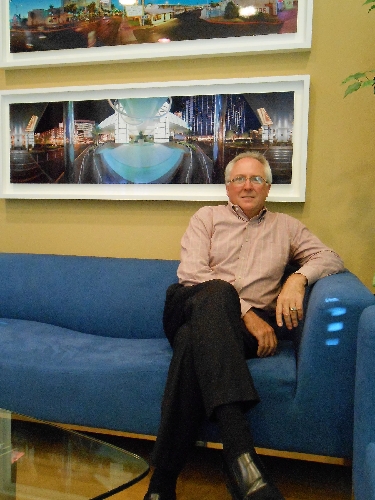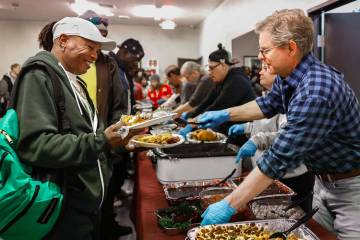Residents remember times of less development, stronger sense of community
Las Vegas natives are a rare breed.
It is estimated that about 80 percent of Las Vegas residents are from elsewhere .
"I don't love Vegas, I'm in love with Vegas," Las Vegas native Brian "Paco" Alvarez said. "That's one of the reasons I have never left this city."
Alvarez, an urban historian, local arts advocate and curator of the Las Vegas News Bureau's 4.5 million-photo archive, was born in 1974 at the Women's Hospital, which once stood on Sahara Avenue. He grew up at 470 E. Naples Drive near the University of Nevada, Las Vegas campus.
He said that only recently have Las Vegans taken to preserving their history.
"It's about time we start looking at the past," he said. "The city has not always embraced its history, but finally the pasta is sticking to the wall."
Alvarez attributed the lack of historical preservation to the economy.
"When the economy was roaring, there was this crash-and-burn mentality because the land was so valuable," he said. "Now we're in this strange gray area where people are beginning to look at ways of (renovating) old spaces."
Bill Marion, who runs a local public relations firm and serves on the Neon Museum's board of directors, was born at the Las Vegas Hospital, the city's first brick-and-mortar hospital.
Marion said the lack of attention on the city's history and natives is due to its young age.
"Imagine Boston in 1770," he said. "They were not too concerned about their history at that time."
Alvarez and Marion said the city is moving in the right direction.
The good ol' days
Allen Richert, whose parents moved to the valley in 1942 and who was born in 1959 at Sunrise Hospital, was the second baby to be born in the newly built facility.
The Las Vegas that Richert remembers is one similar to any other small town.
"It was a tighter-knit community back when I was a kid," he said. "The tourists were made to feel at home, and that hospitality spilled out of the casinos and into the neighborhoods."
After Sunday school, Richert recalled, the neighborhood families would often see movies at the Huntridge Theater, the kids would ride bikes across Sahara Avenue , which, to the south, was mostly desert , and people would go shopping at the Charleston Plaza Mall.
"Main Street felt a little more like main street," he said.
In many ways, Las Vegas was a small town just like any other , with one exception: Gambling was legalized in 1931, positioning it to become the entertainment capital of the world.
Natives such as Marion, who received his undergraduate degree from UNLV when tuition was $283 a semester, recalled the indirect benefits of living in a town that caters to visitors.
"I remember walking over to the Lady Luck in the mornings for their 49-cent breakfast buffet," he said. "And El Cortez would keep cigarettes out on the tables for the gamblers, so I'd walk over there after breakfast and grab a handful of cigarettes for the day. This was all before school started."
Marion also recalled sneaking onto casino pool decks during the summer days and into the lounges at night.
"After seeing a movie, we'd take our dates to the pool decks, like Caesars Palace," he said. "It was a kind of romantic scene."
That was then, this is now
The city has grown up since its early days. The population has spiked since the 1930s, when U.S. Census records show a population of about 5,000. Most recently, Census records estimate a population of nearly 2 million in the greater Las Vegas area.
Clark County is home to the fifth-largest school district in the nation, and at one point, Las Vegas was the fastest-growing city in the nation.
Alvarez said that despite all of the change, the Las Vegas community has not lost its individuality.
"We are a very entrepreneurial state with Libertarian ideals," the former Southern Nevada Vocational and Technical Center student body president said. "There is a community, there is an art form, and our unique cultural values are products of our environment."
Alvarez added that cultural factions such as the burgeoning tech community downtown are continuing the spirit of Las Vegas.
Despite a shift from what Marion calls the "Rat Pack era" to the "Fanny Pack era," he said the city is indeed maturing in its own right.
The hospital Marion was born in was four blocks from the museum he now helps to run.
The Neon Museum, along with other recently constructed cultural landmarks, such as The Smith Center for the Performing Arts and the Mob Museum, are the byproducts of the maturation of a town and its residents, he said.
"These are ways of refreshing the memory (of native Las Vegans) and reflecting on an interesting past," Marion said. "Even events like the Helldorado Parade are ties to our past."
It is a past that is uniquely Las Vegas and one that Alvarez said should be embraced by old-timers and newcomers alike.
"We're our own animal," he said. "(Las Vegas is) sexy. It's cool. It's fabulous."
Contact Paradise/Downtown View reporter Nolan Lister at nlister@viewnews.com or 702-383-0492.

















